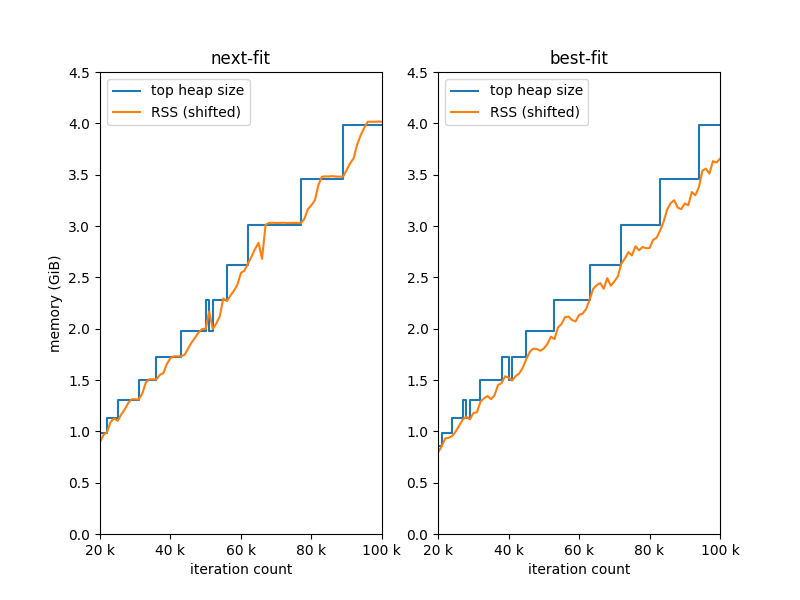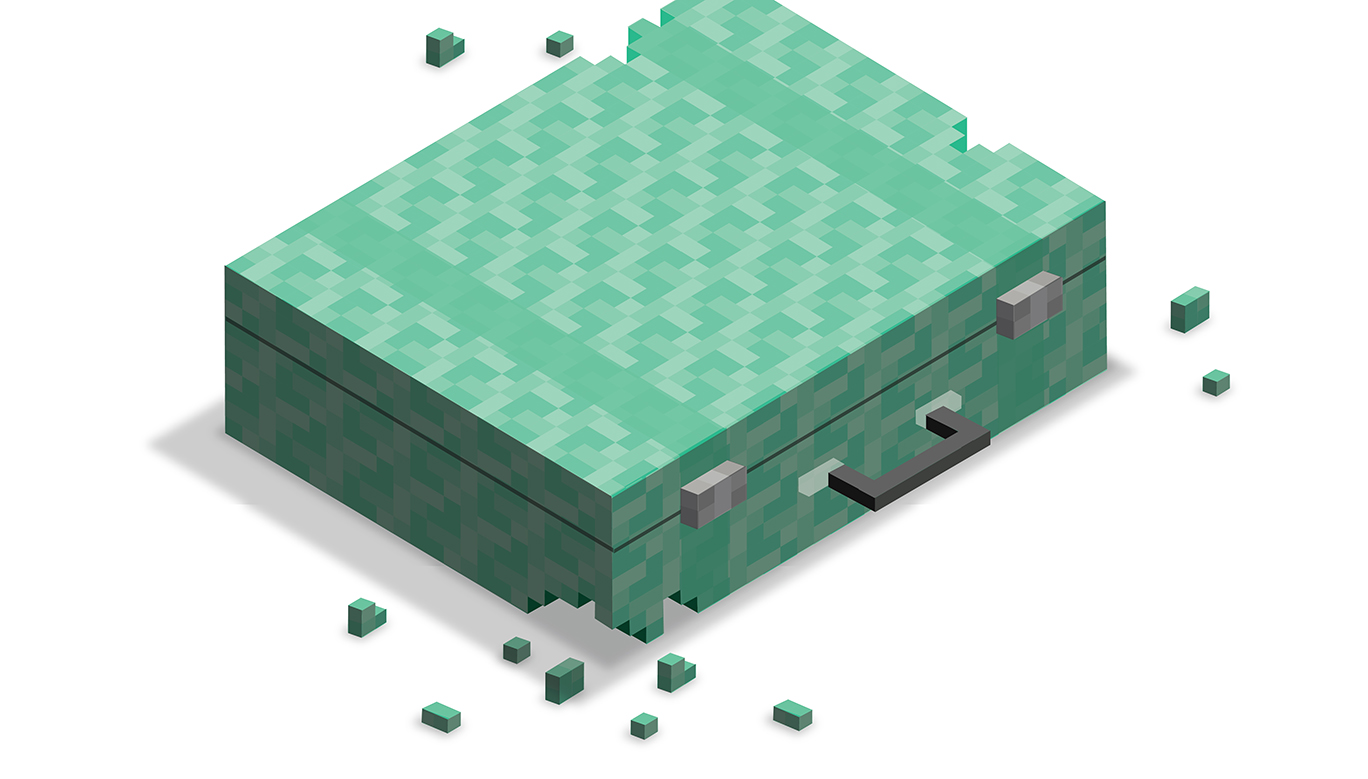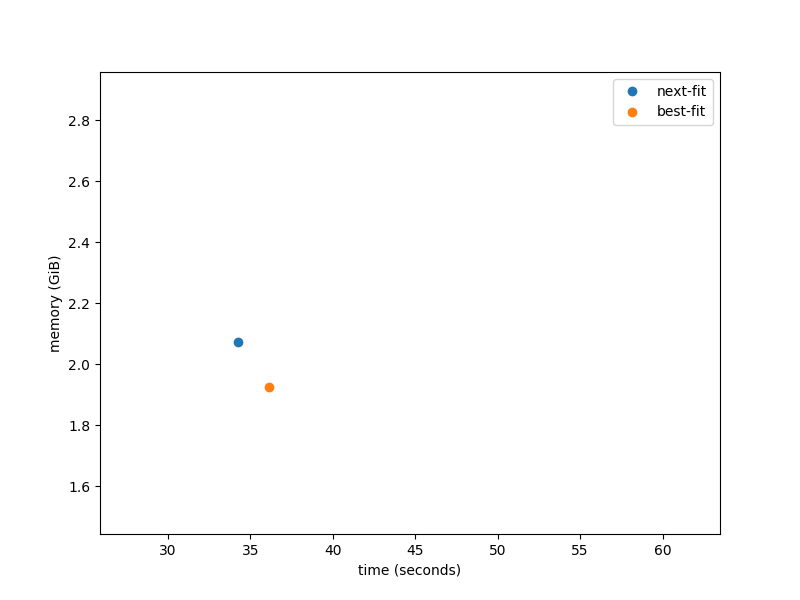(Image by Theresa Bloise)
Since version 4.10, OCaml offers a new best-fit memory allocator alongside its existing default, the next-fit allocator. At Jane Street, we’ve seen a big improvement after switching over to the new allocator.
This post isn’t about how the new allocator works. For that, the best source is these notes from a talk by its author.
Instead, this post is about just how tricky it is to compare two allocators in a reasonable way, especially for a garbage-collected system.
Benchmarks
One of the benchmarks we looked at actually slowed down when we switched allocator, going from this (next-fit):
$ time ./bench.exe 50000
real 0m34.282s
to this (best-fit):
$ time ./bench.exe 50000
real 0m36.115s
But that’s not the whole story. The best-fit memory allocator reduces fragmentation, packing allocations together more tightly. If we measure both time spent and memory used, we see there’s a trade-off here, with best-fit running slightly slower but using less memory:
But that’s not the whole story either. It would be, in a language with
manual memory management, where the allocator has to deal with a
sequence of malloc and free calls determined by the program. On
the other hand, in a language with garbage collection, the GC gets to
choose when memory is freed. By collecting more slowly, we free later,
using more memory and less time. Adjusting the GC rate trades space
and time.
So, in a GC’d language the performance of a program is not described
by a single (space, time) pair, but by a curve of (space, time) pairs
describing the available tradeoff. The way to make this tradeoff in
OCaml is to adjust the space_overhead parameter from its default
of 80. We ran the same benchmark with space_overhead varying from 20
to 320 (that is, from 1/4 to 4x its default value), giving us a more
complete space/time curve for this benchmark. The benchmark is
relatively noisy, but we can still see a separation between best-fit
and next-fit:

Here, best-fit handily beats next fit, whether optimising for time or
space. Note that for every blue point there is an orange point below
and left of it, likely with a different space_overhead value. (Also
note that these numbers come from one of the benchmarks that best-fit
performed the worst on.)
In the default configuration, best-fit picks a point on the curve
that’s a bit further to the right than next-fit: it’s optimising more
aggressively for space use than time spent. In hindsight, this is to
be expected: internally, the space_overhead measure does not take
into account fragmentation, so for a given space_overhead value
best-fit will use less space than next-fit, as it fragments less.
That’s almost the whole story. There are just two questions left: what exactly do mean mean by “memory use” and where did the curves come from?
Measuring memory use
The y axis above is marked “memory use”. There are suprisingly many
ways to measure memory use, and picking the wrong one can be
misleading. The most obvious candidate is OCaml’s top_heap_size,
available from Gc.stat. This can mislead for two
reasons:
-
It’s quantized: OCaml grows the heap in large chunks, so a minor improvement in memory use (e.g. 5-10%) often won’t affect
top_heap_sizeat all. -
It’s an overestimate: Often, not all of the heap is used. The degree to which this occurs depends on the allocator.
Instead, the memory axis above shows Linux’s measurements of RSS (this
is printed by /usr/bin/time, and is one of the columns in top). RSS is
“resident set size”, the amount of actual physical RAM in use by the
program. This is generally less than the amount allocated: Linux waits
until memory is used before allocating RAM to it, so that the RAM can
be used more usefully (e.g. as disk cache) in the meantime. (This
behaviour is not the same thing as VM overcommit: Linux allocates RAM
lazily regardless of the overcommit setting. If overcommit is disabled, it
will only allow allocations if there’s enough RAM+swap to handle all
of them being used simultaneously, but even in this case it will
populate them lazily, preferring to use RAM as cache in the
meantime).
The relationship between top_heap_size and RSS differs between allocators:

This graph shows the same benchmark run with different iteration counts. Each datapoint is a separate run of the program, whose memory use is larger with larger iteration counts. The RSS lines are shifted vertically to align at the left: without this change, the RSS lines are larger than the heap size because they also include binary size. The shifted RSS lines slightly exceed top heap size at the right of the graph, since not quite all of the memory allocated is heap (this happens on both but is more obvious on next-fit).
Notice that the next-fit allocator often uses all of the memory it
allocates: when this allocator finds the large empty block at the end
of the heap, it latches on and allocates from it until it’s empty and
the entire allocated heap has been used. Best-fit, by contrast,
manages to fit new allocations into holes in the heap, and only draws
from the large empty block when it needs to. This means that the
memory use is lower: even when the heap expands, best-fit does not
cause more RAM to be used until it’s needed. In other words, there is
an additional space improvement of switching to best-fit that does not
show up in measurements of top_heap_size, which is why the first graph
above plots memory as measured by RSS.
Modelling the major GC
The curves in the first graph above are derived by fitting a three-parameter model to the runtime and space usage data points. Here’s how that model is derived, and roughly what the parameters mean.
The time taken by major collection, under the standard but
not-particularly-reasonable assumption that all cycles are the same,
is (mark_time + sweep_time) * #cycles. Mark time is proportional to
the size of live heap (a property of the program itself, independent
of GC settings like space_overhead), and sweep time is proportional
to the size of the live heap + G, the amount of garbage collected
per cycle. This amount G is roughly the amount allocated, so the
number of cycles is roughly the total allocations (another property of
the program itself) divided by G.
The result is that the total runtime is roughly some affine linear
function of (1/G), and the total heap size is roughly G plus a
constant. That means that heap size is a function of runtime as
follows:
H = 1/(t-a) * b + c
for three constants a, b, c. Fitting this 3-parameter model
gives the curves in the original graph.
The parameters a, b and c have straightforward
interpretations. a is the vertical asymptote, which is the minimum
amount of time the program can take if it does no collection at
all. This consists of the program code plus the allocator, so best-fit
improves a by being faster to allocate. c is the horizontal
asymptote, the minimum amount of space the program can use if it
collects continuously. This consists of the live data plus any space
lost to fragmentation, so best-fit improves c by fragmenting
less. Finally, b determines the shape of the curve between the two
asymptotes. This is broadly similar between the two allocators, since
changing the allocator doesn’t strongly affect how fast marking and
sweeping can be done (although stay tuned here, as there’s some
work in progress on speeding up marking and sweeping with
prefetching).
Conclusion
Switching allocators from next-fit to best-fit has made most programs faster and smaller, but it’s surprising how much work it took to be able to say that confidently!








